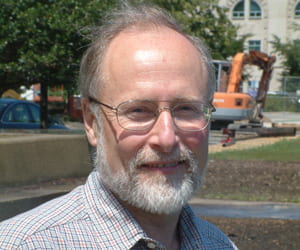THE SUPERPOWERS OF SUPERCONDUCTORS
By: Beth Herbert

The special properties of a superconductor (black) cause a magnet (silver) to levitate. Bethany Hubbard/SCIENCE IN SOCIETY
This summer, in partnership with the Initiative for Sustainability and Energy at Northwestern (ISEN), Science in Society will profile four innovators in the areas of energy and sustainability – researchers who are harnessing the power of science and engineering to better understand and even solve some of the many challenges facing our planet. This week we feature professor and past ISEN-award recipient William Halperin, who studies the properties and potential of superconductors.
Superconductors—special metals that can conduct electrical current with no loss of energy—could one day have a monumental impact on the efficient transmission of power in the United States and around the world. They could also lead to great innovations in medical imaging, drug analysis, and even telecommunications.
While limited amounts of superconductors are already being introduced into the grid, there is much work left to be done, especially in understanding how these compounds actually work and how they can be improved. Science in Society spoke with Halperin, John Evans Professor of Physics at Northwestern, to learn more.

William Halperin
A conductor is a piece of metal that carries electrical charge, like copper carries electrical charge. The electric current copper wires carry provides energy to your computer, lights, etc.
Now, a superconductor is just like that except there is no resistance to the charge. Therefore, no heat is generated when the current moves through the conductor. This is a good thing, because we don’t lose any energy in just heating the wire. That might not seem like a problem if you’re just connecting your computer to the wall, but if you’re conducting electrical current from Niagara Falls to New York City, then that becomes a problem. About seven percent of the energy generated by hydroelectric power at Niagara Falls is lost on its way to New York City.
So superconductors could be a real solution to transmitting energy efficiently?
Exactly. Actually, superconductors have already been introduced into the grid. There is a project that [uses] a substantial amount of superconducting cable in the grid in Long Island. So the possibilities are more than just futuristic.
What are some of the other benefits of superconductors?
Superconductors carry current in a much more compact form than is possible with copper. That means that your wires, instead of being as thick as they are from the wall to your computer, would be as much as an order of magnitude smaller. That might not strike you as being a key component, because you don’t actually devote that much space to the wires [in an office]. But when you talk about supplying the power required in New York City, then you have a different matter. We’re approaching limits in the major cities of the world where it’s not possible to fit more wires. The energy flow is reaching its maximum, spatially constrained amount. That’s a critical planning issue.
Also important is the speed with which electricity can be directed toward one application or another. That has an immediate implication for the stability of the grid in shuffling power from one area to another when there’s a failure. They’re called fault limiters, and superconducting fault limiters are far superior.
Another application is in the cell phone industry. The cell phone industry requires what we call bandwidth—making available more lines of communication to more customers. That means you have to pack the conversations into a narrow region of frequency, frequency being the “conductor” of information. These conductors are described [in terms of] how much frequency is required, just [like the amount of wire] in the electrical analogy. So we call this bandwidth.
The superconducting application here is that filters made with superconductors can slice the bandwidth more precisely than conventional filters. So we can crowd more information to be transferred into the same bandwidth of frequency.
In the problem of developing superconductors, such that they will have an impact on our society, there are two aspects, the first of which is a basic understanding of the process. The second is taking advantage of that basic science [for] feasibility studies and eventually execution in the marketplace or in the societal context.
On which aspect do you and your lab focus?
I’m primarily a basic science person, at least in the area of superconductivity.
We’re working on a material called a high-temperature superconductor. I should mention that “high” is a relative term. By “high” I mean that the cryogenic (very low temperature) requirements necessary to maintain the material in the superconducting state are less severe.
So superconductors can only conduct at very, very low temperatures?
Absolutely. Let’s be more specific. The difference between high and low is the difference between whether it conducts [at the temperature of liquid] nitrogen—[liquid] air, essentially—or whether you require [liquid] helium. For the standard, low-temperature superconductors, they operate in the vicinity of ten degrees from the absolute zero, and the only way you can get there is [by cooling it] with [liquid] helium. But helium is not so readily accessible. And [liquid nitrogen] costs a lot less. It’s about a factor of ten less.
The high temperature superconductor we’re working on is a specific compound—bismuth, strontium, calcium, copper and oxygen. The last two [elements] are the most important—copper and oxygen. They are the key components of all high temperature superconductors.
The oxygen is particularly important. Small variations in the oxygen make it better or worse. There’s what we call an optimum value for how much oxygen you put into the system. What we’ve found in the last month is that it’s not just the amount of oxygen you put in, but how you put it in. The combination of what temperature you heat it to and the pressure of oxygen you use–that history, we found, is quite important.
What are you trying to learn by studying this material?
My area of expertise is in the very high magnetic field applications of superconductivity. One of the questions is how will these superconductors, with the benefit of no loss of energy, perform if the magnetic field in which they’re present is large?
You might say that there is not a very large magnetic field between Niagara Falls and New York City that you’re aware of, and this would be correct. So this might be a non-issue for power transmission. But that’s not the only application of superconductivity.
One in particular that is relevant here is using electrical current flow through a wire to generate magnetic fields. The magnetic resonance imagers (MRIs) in the hospital rely on steady and reliable magnetic fields. Even higher magnetic fields are required in the chemical analysis of drugs and potential drugs—applications in the area of biochemistry, pharmacology, and analytical chemistry. These very large magnetic fields give rise to analysis with commensurately higher resolution. One of the essential pushes of applied superconductivity is to [increase] the capabilities of this analytical technology, called nuclear magnetic resonance, to unprecedented high levels. But this will require very large magnetic fields.
Your work has been partially funded by the Initiative for Sustainability and Energy at Northwestern (ISEN). How has this funding furthered your research?
I have two Department of Energy grants in the area of superconductivity. I had a smaller one at the time I applied for and received ISEN funding. As a consequence of the ISEN funding, that project was increased by 50 percent and, I just heard a few weeks ago, renewed with an increase of 8 percent per year for the next three years. This is good news in a time of severe budget constraints. Then a second project was launched in collaboration with a colleague from the University of Notre Dame, and that was possible directly as a result of ISEN funding. So this is all positive news, that we’re able to use our intellectual resources to try to develop about basic understanding of superconductivity.
